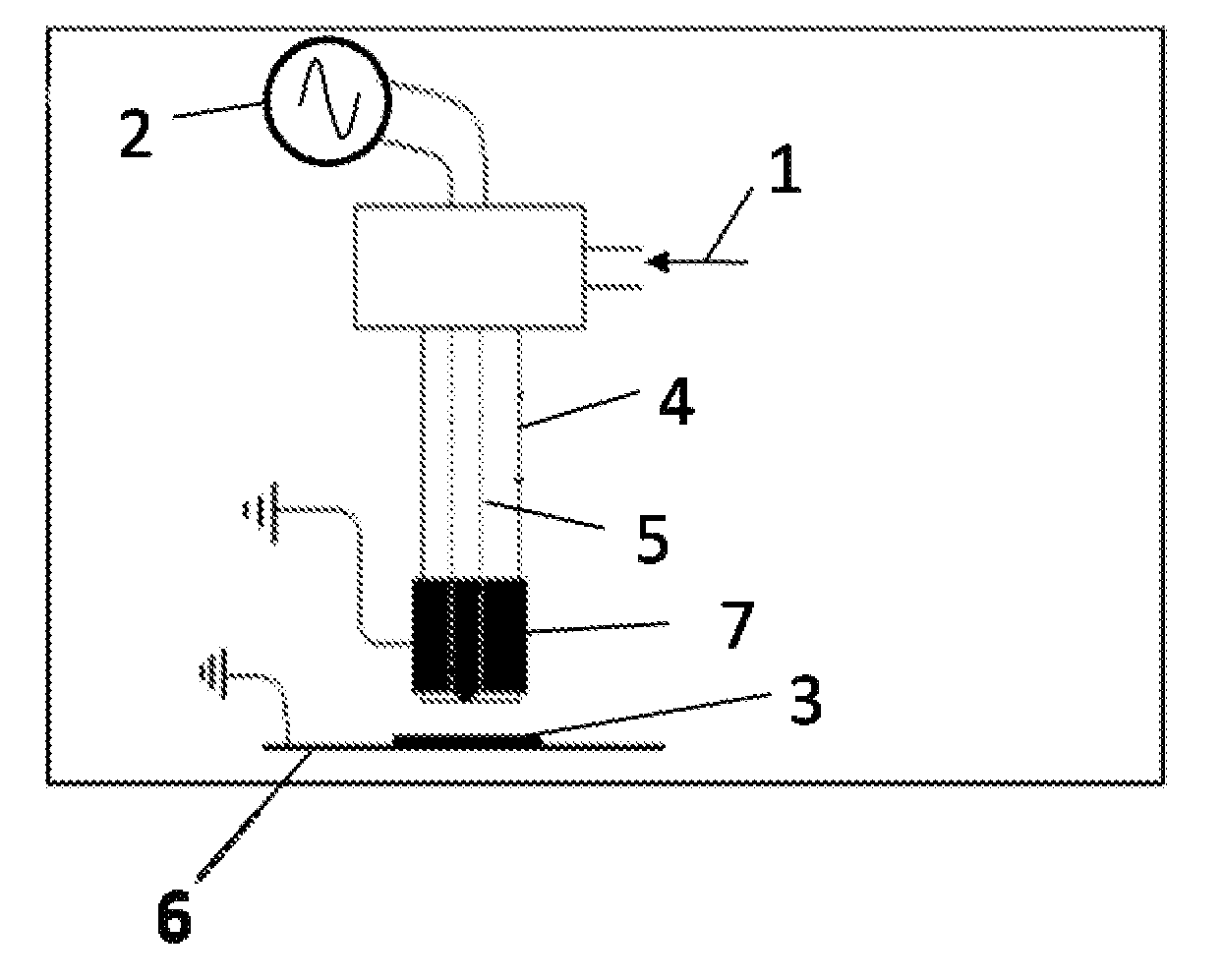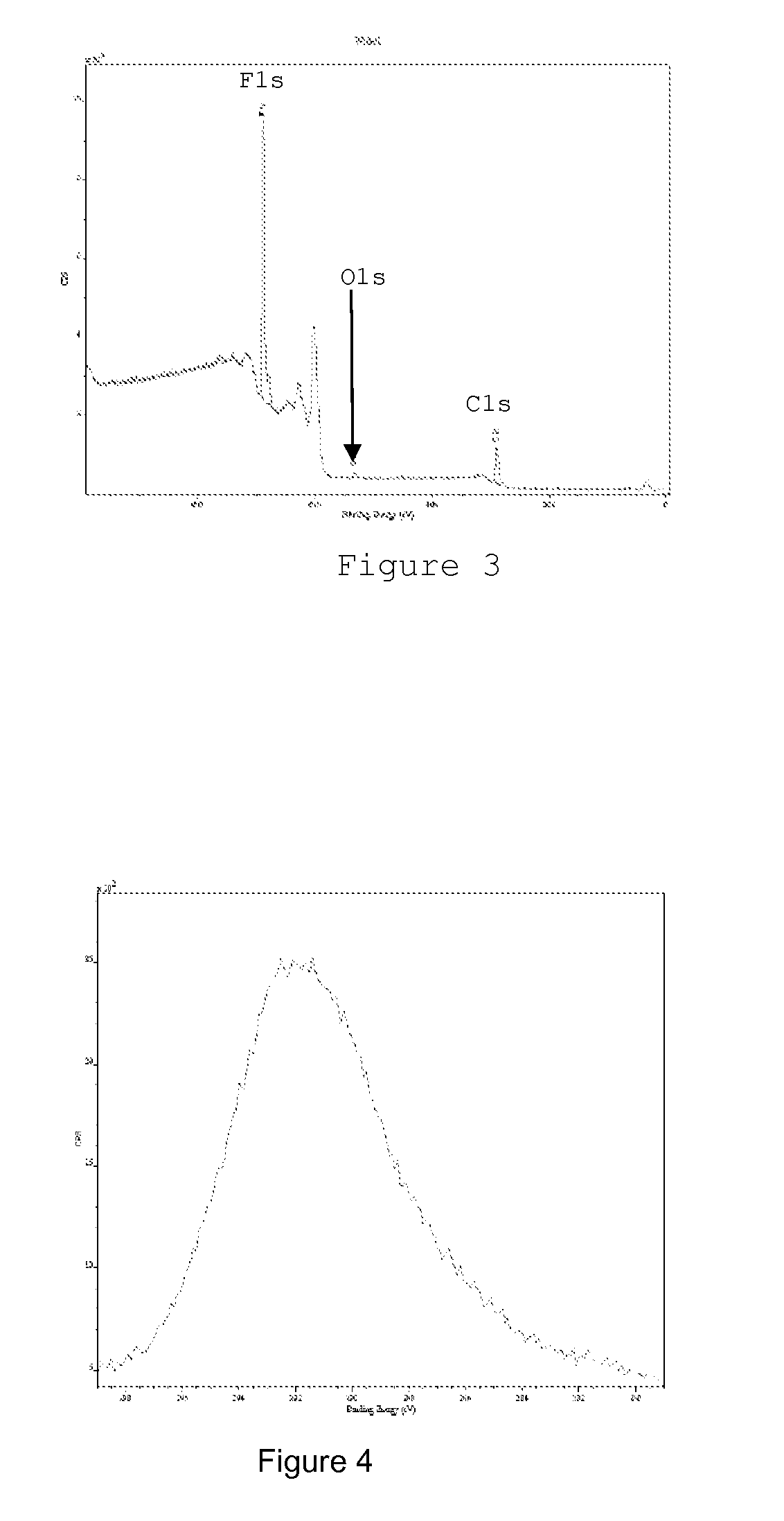Method for depositing a fluorinated layer from a precursor monomer
a precursor monomer and fluorinated layer technology, applied in the direction of metal material coating process, plasma technique, coating, etc., can solve the problems of reducing the hydrophobicity of the surface, requiring the use of extremely reactive gases, and requiring the use of sufficiently reactive compounds, so as to reduce the pressure, facilitate handling, and reduce the effect of toxicological and environmental controversy
- Summary
- Abstract
- Description
- Claims
- Application Information
AI Technical Summary
Benefits of technology
Problems solved by technology
Method used
Image
Examples
example 1
[0050]Example 1 shows a deposit of perfluorohexane on PVC, achieved in post-discharge under the following conditions:
[0051]A sample 3, as a PVC film of 4 cm×4 cm of the Solvay brand is cut out, cleaned with methanol and isooctane and placed at the outlet (at 0.05 cm) of a cold plasma torch (FIG. 1) (discharge with a dielectric barrier) operating at atmospheric pressure. The fluorinated monomer (perfluorohexane) is placed in a glass (Pyrex) bubbler immersed in a Dewar vessel containing a mixture of acetone and dry ice. The temperature of the mixture, and therefore of the monomer, is about −80° C. The vapor pressure of perfluorohexane at this temperature is about 1.2 mbars. An argon flow is then sent into the bubbler, with an initial overpressure of 1.375 bars. The argon / perfluorohexane gas mixture 1 is carried away into the inside of the torch. A plasma is initiated with a voltage of 3,200 Volts and a frequency of 16 kHz for 1 minute.
example 2
[0052]Example 2 shows a deposit of perfluorohexane on PVC produced in a discharge with a dielectric barrier under the following conditions.
[0053]The sample is attached onto the inside of the external electrode 9 of a discharge with a cylindrical dielectric barrier. The > electrode 8, the one to which the voltage is applied, is the internal electrode covered with an alumina cup. Alumina cement provides the seal (FIG. 2).
[0054]The fluorinated monomer is brought into the discharge as in Example 1. A treatment of 1 minute at a voltage of 3,000 V and a frequency of 20 kHz is applied subsequently (treatment in the discharge area).
[0055]The unambiguous presence of a fluorinated layer at the surface of the PVC film is proved by X photoelectron spectroscopy. The spectra of FIGS. 3 and 4 illustrate full survey and magnification of the carbon area. The presence of fluorine of CF2 groups is clearly identified via the fluorine peak located at 689 eV and the position of the carbon peak, 291.5 eV ...
example 3
[0057]Example 3 is identical with Example 1, except for the substrate, which in this example is polyethylene.
PUM
| Property | Measurement | Unit |
|---|---|---|
| Temperature | aaaaa | aaaaa |
| Pressure | aaaaa | aaaaa |
| Pressure | aaaaa | aaaaa |
Abstract
Description
Claims
Application Information
 Login to View More
Login to View More - R&D
- Intellectual Property
- Life Sciences
- Materials
- Tech Scout
- Unparalleled Data Quality
- Higher Quality Content
- 60% Fewer Hallucinations
Browse by: Latest US Patents, China's latest patents, Technical Efficacy Thesaurus, Application Domain, Technology Topic, Popular Technical Reports.
© 2025 PatSnap. All rights reserved.Legal|Privacy policy|Modern Slavery Act Transparency Statement|Sitemap|About US| Contact US: help@patsnap.com



